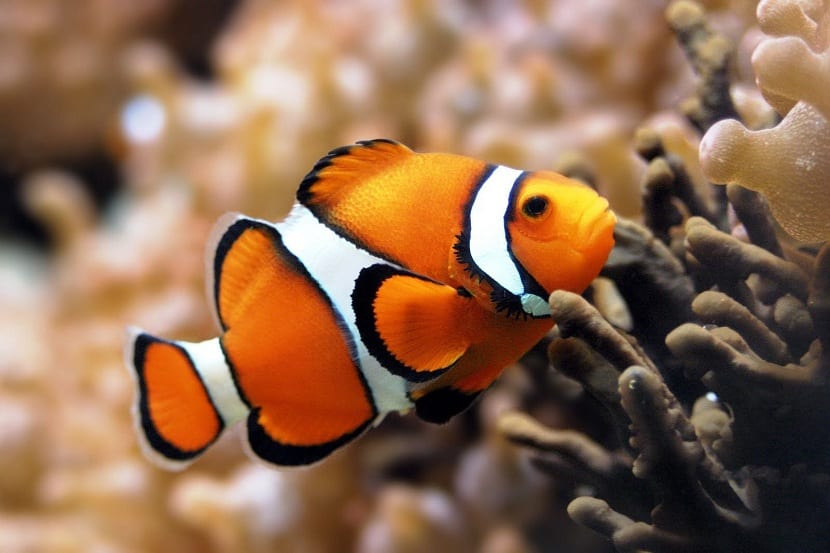
Today we will talk about a very recognized and famous species of fish throughout the world. Scientific name Amphiprion ocellaris, we will know the clown fish. He is easily recognized for his white and orange stripes and for being in the film of «Finding Nemo«.
Do you want to know everything about this fish?
Classification and characteristics of the clownfish
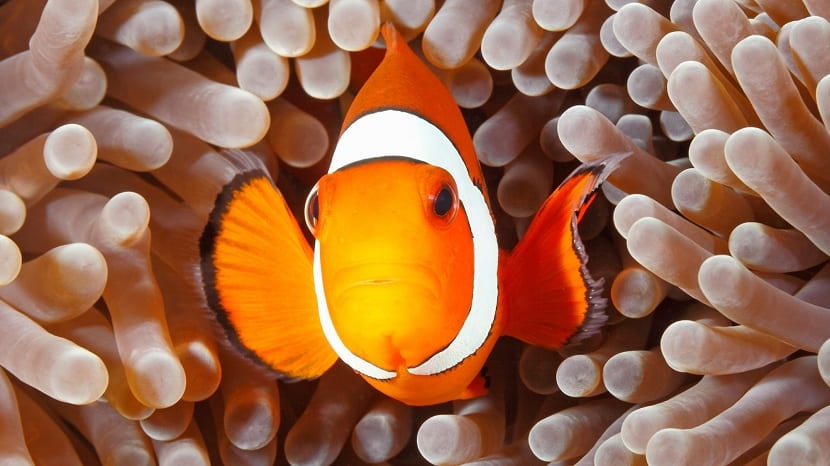
The clownfish belongs to the order Perciformes, the family Pomacentridae and the subfamily Amphiprioninae. It is also known as the Anemone Fish. This second name is due to the fact that, in order to survive in natural environments, it needs to work together with anemones.
Have been found so far 30 different species of clownfish and all the species that belong to the Pomacentridae family are called Anemone Fish because of their symbiosis.
These fish have a length of between 10 and 18 centimeters. The females are bigger than the males. Not all clown fish have the same color and the same alternating bands in orange and white, but there are many colors such as yellow, red, pink and even darker tones.
The color of this fish is divided into three stripes that start from the head. The edge of the fins is usually black.
By developing alongside anemones and working together to survive, clownfish have developed skin containing stinging cells covered by a layer of mucus. This foot helps protect them from the venom of the anemone.
The life expectancy in the natural state can be between 5 and 10 years old.
Habitat and food
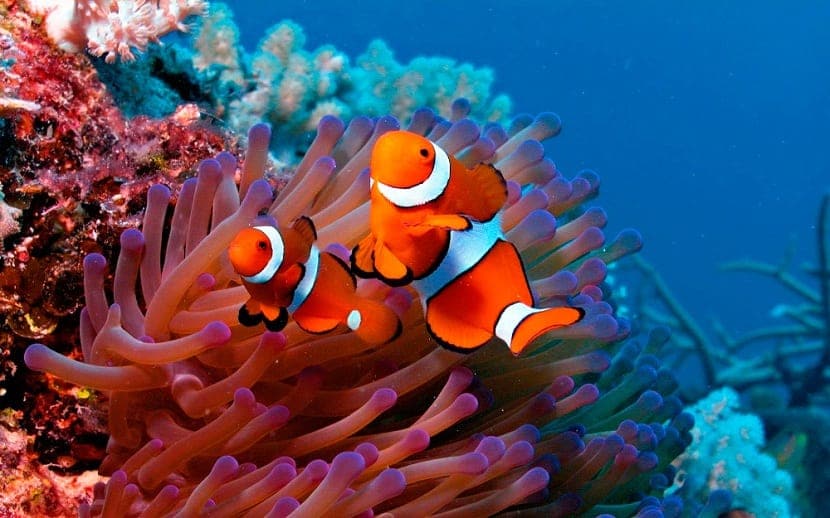
The natural range of the clownfish is in the Pacific and Indian Ocean. It is also found on the Australian Great Barrier Reef and in the Red Sea. They are usually scattered around these areas, since they do not need much depth and look for coral reefs that are not very deep and where anemones are found.
Clownfish look for anemones because they have established themselves throughout evolution a relationship of mutualism. That is, a symbiotic relationship in which the two species win. Depending on the species of clownfish that we meet, they have one preference or another for several species of anemone in particular.
These fish benefit from the tentacles of anemones, as it is great for them to protect themselves and survive. The tentacles of anemones are toxic and, having developed a mucosa that protects them from their venom, they are not affected. To thank the anemones for their protection, the clownfish is in charge of eating possible parasites, algae that could harm it and the residues that can remain in its tentacles after feeding. In addition, the fecal waste of the clownfish suppose an extra contribution of nutrients for the anemone.
Not much is known about the mucus that protects clownfish from being affected by the venom of the anemone, but it is known that one of its main characteristics is that it lacks a substance that makes it the action of nematocysts is triggered.
This is not always the case. As they are born and grow, they develop the mucosa and become immune to the toxins of the anemone and adapt to the terrain. Also, for the relationship to be established, the fish has to gently swim across the anemone as a dance, so that the anemone gets used to it and does not try to sting continuously.
The feeding of these fish is omnivorous. They eat a variety of foods of all kinds as small mollusks, algae, zooplankton and crustaceans. Being immune to the venom of anemones, many clownfish eat the pieces of tentacle that are shed from the anemones.
Behavior
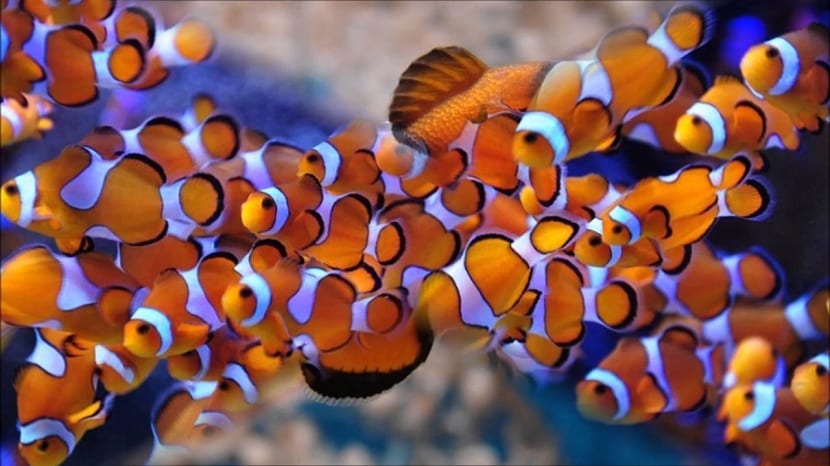
The clownfish is very territorial and aggressive. For this reason, it is largely able to protect the anemone in the mutualistic relationship. In society, clownfish live in a hierarchy where the largest and most aggressive female is the boss. If the dominant female dies, the larger male replaces her by changing sex.
These fish are monogamous, so the only ones that reproduce are the dominant male and female. When the male changes sex to female because the female dies, the second largest male acts as the new reproducer.
Reproduction
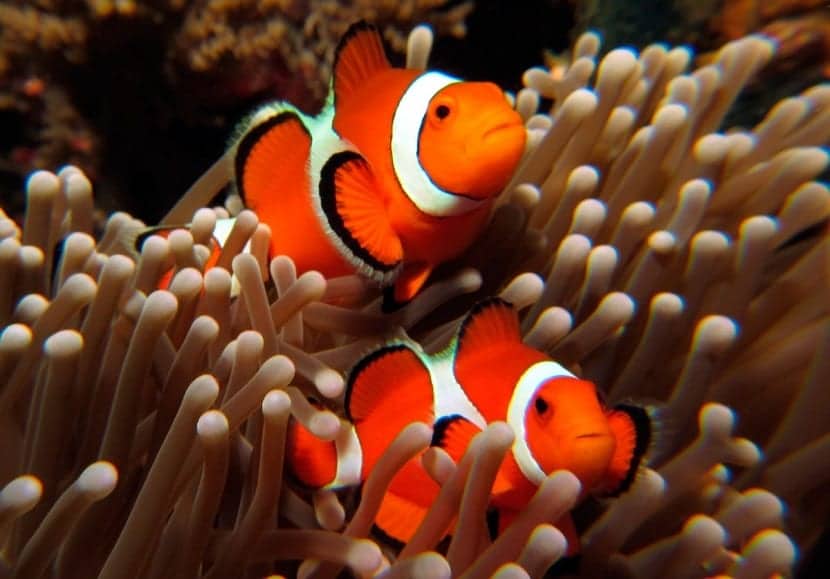
The clownfish is oviparous, that is, it is born through eggs. Fertilization between the dominant female and the largest male occurs externally. Both release their gametes to the environment where fertilization takes place.
Reproduction is very vulnerable to temperatures. If the water temperature rises, they begin to reproduce. As they are fish from tropical waters and are more or less at high temperatures all year round, they reproduce throughout the year.
Before starting the act of fertilization, the male cleans and prepares an area near the anemone so that the female can later deposit the eggs. When the female lays the eggs, the male is responsible for spraying his sperm on them to fertilize it. During the incubation process, the male is responsible for oxygenating the eggs by flapping the fins near them to create currents. If an egg is not in good condition, the male removes them. To protect them during incubation, the male fish becomes very aggressive against any invaders.
Care and compatibility
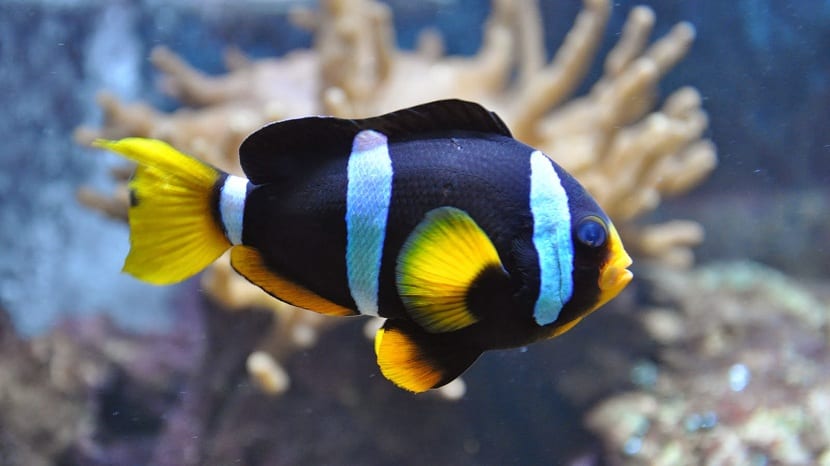
If we want to have a clownfish in our aquarium we will need to meet some requirements for the proper maintenance of its habitat. These fish they need 75 liters of water for each specimen to live well and the water, being fish of tropical origin, must be kept between 24 and 27 degrees of temperature.
As for the decoration of the aquarium, it is very important that each fish has its own anemone to be able to live with it. Being so aggressive and territorial they will fight with the other fish for their anemone. It is important to place coral grains, as clownfish tend to inhabit coral reefs.
Keep in mind that these fish are very territorial and they will not get along with other fish of the same species. It is not recommended to have several clown fish unless you have aquariums of 300 and 500 liters of water, where they can establish a hierarchy.
Clown fish swim very slowly, so it is not advisable to put them with other carnivorous fish and larger than them. Ideally, place them with species that are more related to them such as Damsels, Maidens, Angels, Gobies, Blennies, Surgeonfish, and Gramma Loretos.
Diseases and prices
Clownfish can suffer from diseases typical of marine fish such as tuberculosis, cysts, worms, velvet, white spot and other bacterial diseases.
To prevent our fish from getting sick, we must always keep the aquarium clean, change and clean the filters, maintain the temperature correctly, clean algae remnants and if any fish dies remove it immediately. It is advisable to have a hospital aquarium for when a fish shows a disease, remove it and treat it there.
As for prices, they vary depending on the color. You can find them between 16 and 26 euros the copy.
Now you know something more about these precious fish and how to keep them healthy in your fish tank.